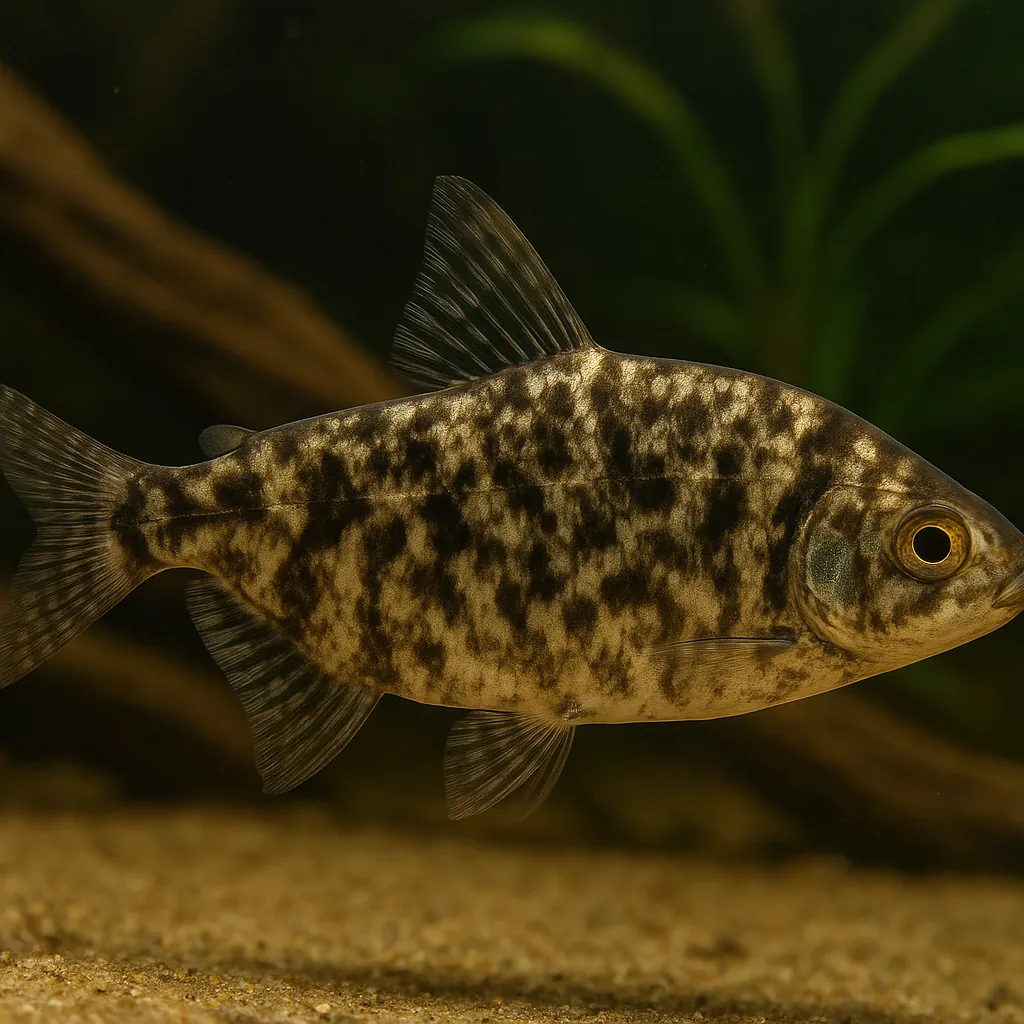
Marbled headstander
Introduction
The Marbled headstander (Abramites hypselonotus) is a captivating freshwater fish known for its unique head-down swimming posture. This distinctive behavior, combined with its striking marbled pattern, makes it a favorite among aquarists seeking an unusual addition to their tanks. While generally peaceful, the Marbled headstander requires specific care to thrive, making it suitable for hobbyists with some experience in fishkeeping.
Care and Environment
Providing the right environment is crucial for the well-being of the Marbled headstander. A minimum tank size of 120 liters is recommended for a single fish, but a larger tank of at least 200 liters is ideal for keeping a small group. These fish are active swimmers and appreciate ample space to move.
What are the ideal water parameters for Marbled headstanders?
They thrive in water temperatures between 22–28°C, with a pH range of 6.0–7.5, and water hardness between 2–18 dGH. Maintaining stable water conditions is essential, as they are sensitive to fluctuations.
Filtration should be efficient to keep the water clean, but avoid strong currents, as Marbled headstanders prefer moderate water flow. Lighting can be subdued, mimicking their natural habitat.
What should I include in the tank setup?
Incorporate driftwood, rocks, and hardy plants like Anubias or Java fern to provide hiding spots and reduce stress. Be cautious with soft-leaved plants, as they may be nibbled on. A sandy or fine gravel substrate is suitable.
As omnivores, Marbled headstanders accept a variety of foods. Offer high-quality flake or pellet food supplemented with live or frozen options like bloodworms, brine shrimp, and daphnia. Including vegetable matter such as blanched peas or zucchini is beneficial.
Are there any specific challenges in keeping Marbled headstanders?
They can be fin nippers, especially if not kept in appropriate group sizes. Additionally, they may consume soft-leaved plants if their diet lacks sufficient vegetable content.
Origin and Habitat
Native to South America, the Marbled headstander inhabits the river basins of the Amazon and Orinoco rivers, spanning countries like Colombia, Peru, Brazil, Bolivia, and Venezuela. They are found in various environments, from main river channels with turbid, flowing water to minor tributaries and backwaters. During the rainy season, they also venture into flooded areas. These habitats typically feature moderate to strong currents, rocky substrates, and abundant vegetation.
Temperament and Compatibility
Marbled headstanders are generally peaceful but can exhibit territorial behavior, especially as they mature. They are best kept in groups of six or more to distribute any aggression and reduce stress. Suitable tank mates include similarly sized, non-aggressive species such as tetras, rasboras, guppies, mollies, platies, and corydoras. Avoid housing them with long-finned or slow-moving fish, as they may nip at fins.
Can Marbled headstanders be kept with other fish?
Yes, they can coexist with a variety of peaceful, similarly sized fish. However, monitor interactions to ensure harmony within the tank.
Do they need to be kept in groups?
Yes, keeping them in groups of six or more helps minimize aggression and promotes natural behavior.
Interesting Facts
The Marbled headstander gets its name from its unique feeding behavior, often adopting a head-down, tail-up position while grazing on algae and searching for food. This distinctive posture adds to their appeal in home aquariums. They are known to live up to 10–15 years with proper care, making them a long-term commitment for aquarists. Despite their popularity, breeding Marbled headstanders in captivity is rare, and there are no well-documented cases of successful reproduction in home aquariums.
Sources
All information in this article has been gathered from the following reputable sources:
Overview
Recommended Tank Size 52.8 Gallons (for groups of 6 or more) |
Minimum Group Size 6 |
Minimum Tank Volume 31.7 Gallons |
Maximum Adult Length 5.5 inches |
Average Adult Length 4.7 inches |
Shoaling (6+ required) Yes |
Preferred Water Type Freshwater, slightly acidic to neutral |
Temperature Range (°C) 22–28 |
pH Range 6.0–7.5 |
Water Hardness (dGH) 2–18 |
Typical Lifespan (years) 10 years |